If you want to strengthen your upper body, you should work on your shoulders first.
And dumbbell shoulder exercises are among the best ways to build up shoulder mass and get full, dense shoulders.
Unlike the fixed motion of barbells and machines, dumbbells allow for a wider range of motion and increased stabilization demands.
It allows you to isolate better the heads of the deltoids: the anterior deltoids (front), lateral deltoids (side), and posterior deltoids (back).
Beginners and advanced lifters use dumbbells to build a strong foundation of strength. They are easier on your wrist, elbow, and shoulder joints.
To effectively train the shoulder, first, we will understand the shoulder anatomy, and then we will look at the how-to effectively train with dumbbells and the best shoulder dumbbell exercises and pro-tips
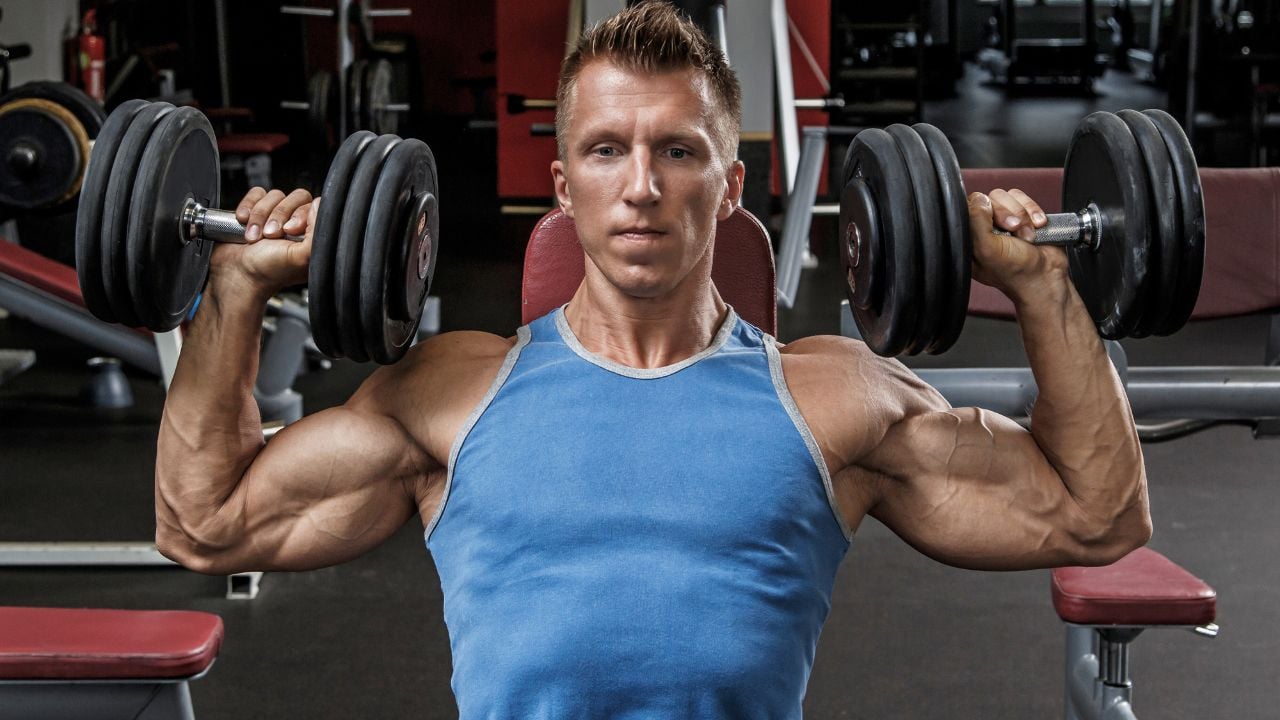
- How To Structure Dumbbell Shoulder Workout Plan
- How To Get a Bigger Shoulder With a Dumbbell
- 12 Best Dumbbell Shoulder Exercises
- 1. Dumbbell Shoulder Press
- 2. Arnold Shoulder Press
- 3. Dumbbell Lateral Raise
- 4. Dumbbell Front Raise
- 5. Dumbbell Upright Row
- 6. Dumbbell Bent Over Raise
- 7. Dumbbell Shrug
- 8. Seated Neutral-Grip Overhead Dumbbell Press
- 9. Dumbbell lateral raise
- 10. Incline Bench Rear Lateral Raise
- 11. Side-Lying Rear Fly
- 12. Dumbbell Push Press
- Dumbbell Shoulder Workout Technique and Routine Plan
- Training Plan As Per Your Goal
- Training Volume (Sets and Reps)
- Dumbbell Shoulder Workout Routine For Beginner
- Workout Routine For Intermediate
- Workout Routine For Advance
- Note:
- Shoulder Muscles Anatomy
- 1. Deltoids
- 2. Rotator Cuff
- 3. Trapezius
- Benefits Of Doing Shoulder Workout With Dumbbell
- FAQs
- How can I work my shoulders with dumbbells at home?
- Are dumbbell shoulder exercises safe?
- Can I do dumbbell shoulder exercises every day?
- How many shoulder exercises per workout
- How do you target the three parts of the shoulder?
- Conclusion
How To Structure Dumbbell Shoulder Workout Plan
You must design and execute a dumbbell shoulder workout routine to build mass and strength.
The number of reps and sets will depend on your fitness level, weekly workout frequency, and strength training goals. Here are some guidelines to follow:
- For strength gains, do 4 to 6 sets of 1 to 6 reps for each exercise with a weight of at least 85% of your one-repetition maximum (1RM). The fewer reps you perform, the closer to 100% of your 1RM you should strive for.
- If you’re targeting muscle growth, or hypertrophy, perform three sets for each exercise with a weight load that is 70 to 85% of your 1RM, completing 8 to 12 reps in each set.
- For endurance training, it’s generally advised to perform higher reps—around 15 to 20 per set—with a moderate weight of approximately 50 to 70% of your 1RM.
How To Get a Bigger Shoulder With a Dumbbell
To get bigger shoulders with dumbbells, you can perform various exercises targeting the different parts of the shoulders.
Weight training with dumbbells can be beneficial for achieving hypertrophy and increasing impact on a specific muscle group.
One of the best ways to put on some serious shoulder mass and get full, dense shoulders is by doing dumbbell shoulder exercises.
There are two basic kinds of dumbbell shoulder workouts: Presses and Arm raises.
- In Dumbbell Shoulder Presses Exercises, you begin with your arms bent, the weight up to about shoulder height, and lift the dumbbells straight up over your head. Presses involve both the deltoids and the triceps.
- Dumbbell shoulder raises Workouts involve lifting your extended arm upward in a wide arc, better isolating the head. It would be best if you did raises to the front, to the side, and to the rear.
To strengthen your shoulder, you should try increasing the intensity of your workout. The drop-set, forced reps, and the pause-and-go method are some methods for intensifying your workouts.
However, with dumbbells, you can easily increase the intensity of your workout on your own.
For example, if you want to do drop sets on the barbell bench press, you’ll need a partner to drop the weight from the barbell.

12 Best Dumbbell Shoulder Exercises
Dumbbells are among the most easily available free weights, so exercises using them are ideal for beginners and can be easily included in home workouts.
Here is a list of the 12 best dumbbell shoulder exercises and a workout to help you build well-developed shoulders.
1. Dumbbell Shoulder Press
Dumbbell Shoulder Press exercises are an excellent variation of barbell shoulder Press. The fact is that the dumbbells allow a full range of motion.
It is one of the best exercises for building shoulder mass and strength, specifically the front and side deltoid muscles.
They are performing the exercise while the seated shoulder press is a stricter version than standing and prevents cheating the weight upward using momentum generated by the legs.
This is one of my favorite exercises that I do every time I work out my shoulders.
Here are some other good ways to do dumbbell shoulder presses at home.
- Seated DB Shoulder Press
- One Arm Shoulder Press
- Alternate Dumbbell Shoulder Press
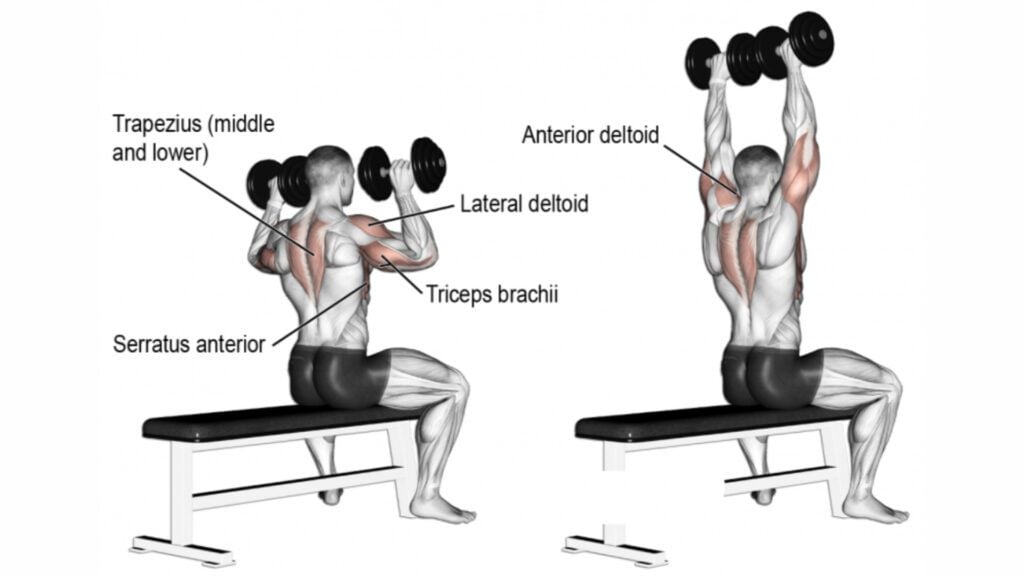
How To Do It
- Sit at the end of a flat bench, holding a dumbbell in each hand with palms facing forward.
- Lift the dumbbells overhead until they nearly touch at the top, and then lower them as low as possible.
- Feel a good stretch at the bottom, and then continue the next rep.
- Repeat the steps for your chosen number of reps and sets.
- Try to keep the weight the same throughout your workout.
Tips
- Exhale when you’re working hard, and inhale when you’re resting.
- Keep a controlled motion and avoid jerks.
- Go as heavy as you can possibly go.
2. Arnold Shoulder Press
The Arnold Shoulder Press is a unique and effective shoulder exercise popularized by Arnold Schwarzenegger.
This exercise combines a standard shoulder press with a rotational movement, targeting multiple parts of the deltoid muscles.
It gives you a wide range of motion as you lower the dumbbells well down in front. This makes your shoulder muscles really stretch out, which other shoulder exercises don’t.
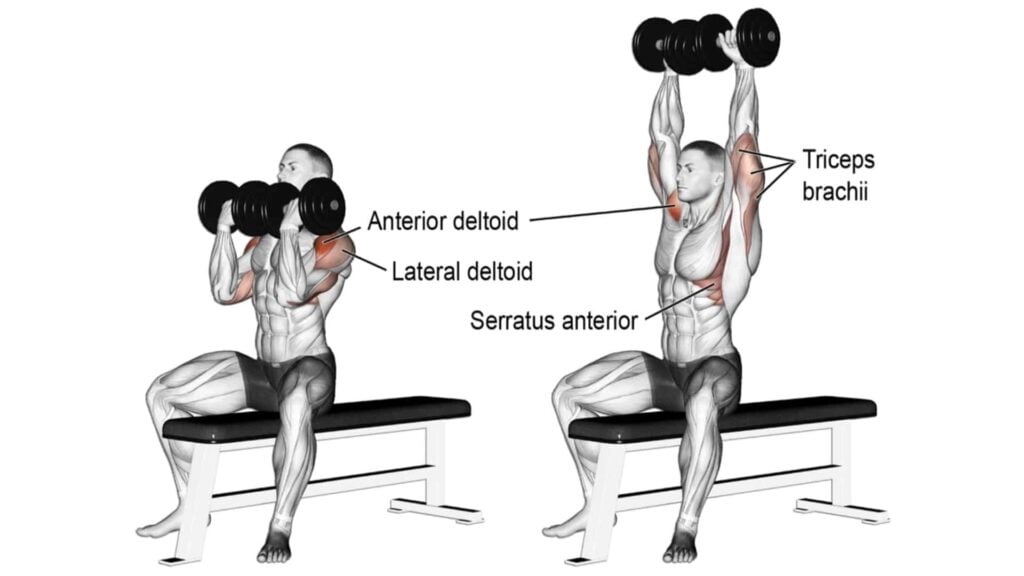
How To Do It
- Start seated or standing, holding a dumbbell in each hand at shoulder height with elbows bent and palms facing towards you.
- As you press the dumbbells overhead, simultaneously rotate your arms so that your palms face away from you at the top.
- Pause for a second at the top, then slowly lower the dumbbells back down to the starting position, reversing the rotation of your wrists.
- Repeat the desired number of reps.
Tips
- Inhale when you lower the weight and exhale when you lift.
- Keep a controlled motion and avoid jerky movements.
- Keep a strict form. Do not lock your arms overhead.
- Due to the complexity of the movement, begin with lighter weights to master the technique.
3. Dumbbell Lateral Raise
The dumbbell lateral raise works the side of the shoulders, also called the lateral head. It’s an isolation exercise that primarily targets the lateral head of the shoulder.
You might need to use lighter weights with isolation exercises as more load is placed on a specific body part.
As a lighter weight is used, more reps can be used — anything from 10 to 20 reps.
Other Variations:
- Seated dumbbell lateral raise
- Leaning dumbbell lateral raise
- Incline dumbbell lateral raise
- Single-arm dumbbell lateral raise

How To Do It
- Hold a dumbbell in each hand and bring the weights together in front of you.
- The palms should be facing each other.
- Now bend your elbows and raise the dumbbells to your sides.
- Lift them to a point slightly higher than your shoulders. Hold at the top for a second.
- Now lower the dumbbells in a controlled manner back to the starting position.
Tips
- This exercise is important, and the form is a big part of it.
- Don’t just swing your arms. Keep controlled motion throughout the exercise.
- Perform a warm-up with 50% weight for 1-2 sets.
- You should always use weights that you can handle comfortably.
4. Dumbbell Front Raise
A dumbbell front raise is an excellent exercise to isolate the anterior deltoid Muscle. This exercise helps to build muscle mass in the front head of the deltoids.
Front dumbbell shoulder raise exercises can be done standing and seated with a pair of dumbbells. This exercise is done in an alternating movement.
This exercise can work well with a medium to lightweight for higher reps.
It’s a challenging exercise to do with heavy weights, so focus on growing the muscles rather than maxing out on a heavy load.
The best ways to do dumbbell shoulder presses at home are:
- Alternate Dumbbell front raise
- Two Arm single dumbbell Front Raise
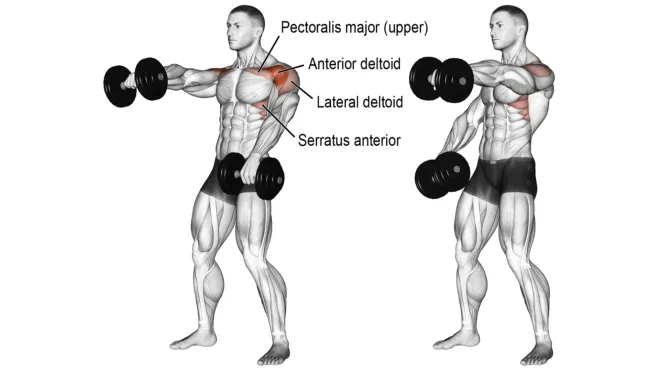
How To Do It
- Stand holding a pair of dumbbells across the front of your thighs.
- Your feet are shoulder-width apart, and your knees are slightly bent.
- Raise one dumbbell (say right hand) in front until it reaches just above shoulder level.
- Now lower the weight (of the right hand) while raising the left in front of you.
- Perform this exercise in this alternating manner.
- Aim for 3 to 4 sets of 12 to 15 reps.
Tips
- Pause momentarily at the top before slowly lowering the dumbbell back to the starting position.
- Keep a controlled motion and avoid jerky movements.
- Avoid arching of the lower back.
- Concentrate on training the front delts, raising dumbbells before you, and not raising outside the body.
5. Dumbbell Upright Row
Research shows that the upright row is one of the best exercises for building shoulder strength and stability. It activates all major shoulder areas, excelling for upper body stability and conditioning.
The dumbbell upright row can be used to target your shoulders or traps, depending on how wide or narrow you keep your elbows during the movement.
The narrow grip focuses on Trapezius, and the wider focuses on the entire shoulder girdle.
Furthermore, the wider grip allows some cheating movement, thereby allowing you to lift more weight.
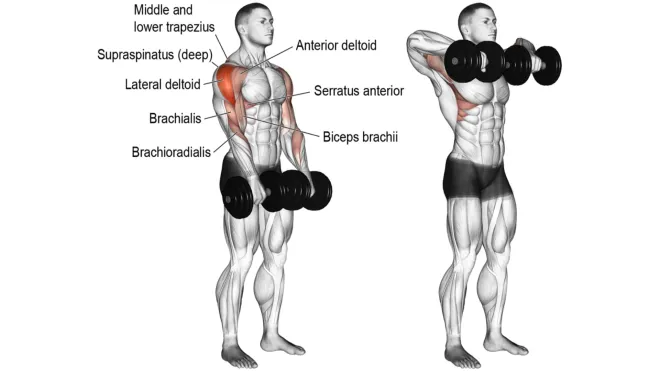
How To Do It
- Stand with your feet shoulder-width apart, maintaining a straight posture.
- Hold a dumbbell in each hand with an overhand grip (palms facing your body).
- Lift the dumbbells by pulling them straight up towards your chest.
- Aim to bring the dumbbells up to the level of your collarbone, just below your chin.
- Squeeze your shoulder blades together at the top of the movement.
- Inhale as you slowly lower the dumbbells back down to the starting position.
- Aim to perform 8 to 12 reps.
Tips
- Keep a controlled motion and avoid jerky movements.
- Keep your elbows close to your body throughout the movement.
- Don’t allow your back to arch as you pull the weight up.
Read More: How To Do Upright Row, The Muscle Worked, Proper Form, Benefits and Its Variations
6. Dumbbell Bent Over Raise
If you want to build a bigger and stronger rear delt, you should add bent-over lateral raises to your shoulder workout routine.
This exercise specifically hits the rear deltoid head and isolates it better than any other shoulder exercise.
There are many variations of bent-over lateral raise that you can add to your workout routine, and all have their own unique benefits.
- One Arm Dumbbell Bent Over Lateral Raise
- Seated Dumbbell Bent Over Lateral Raise
- Head-Supported Bent Over Lateral Raise
I enjoy this exercise because I feel that my shoulders are fully trained after doing it.

How To Do It
- Sit on the edge of a bench or chair with your feet flat on the floor and shoulder-width apart.
- Bend forward from your hips, hinging at your waist, until your torso is roughly parallel to the floor.
- Hold a dumbbell in each hand, palms facing inward, and arms hanging straight down.
- Raise your arms out to the sides.
- Focus on squeezing your shoulder blades together as you lift.
- Aim to raise your arms until they are parallel to the floor or slightly higher.
- Now lower the dumbbells back to your sides.
Tips
- Don’t swing the dumbbells. Use controlled movement.
- Keep your elbows slightly bent.
- Focus on squeezing your shoulder blades together as you raise the dumbbells.
- Keep form strict to isolate the rear delts.
7. Dumbbell Shrug
The dumbbell shrug is a great exercise for building shoulder strength, improving posture, and relieving neck and shoulder pain.
This isolation exercise builds bigger, stronger trapezius muscles, specifically the upper trapezius muscles.
They are suitable for both beginners and pros because they can be performed with various weights. Traps, a stubborn muscle group for many, can be trained fairly frequently during the week.
After a shoulder workout, I use it to train and build strong trap muscles.
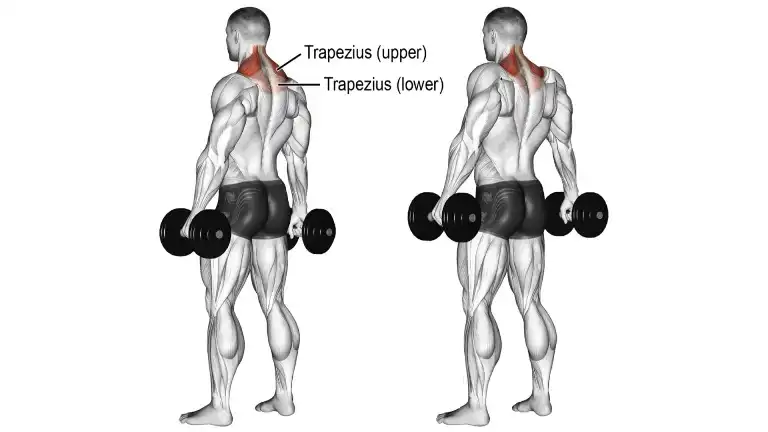
How To Do It
- Stand with your feet shoulder-width apart.
- Hold a dumbbell in each hand with your arms extended by your sides.
- Keep your shoulders relaxed and your core engaged.
- Inhale and lift your shoulders towards your ears, making a shrugging motion.
- Hold the contraction for a second or two, then exhale and lower your shoulders back down to the starting position.
- Repeat the movement for the desired number of repetitions, typically 8-15 reps for 2-3 sets.
Tips
- Try not to move anything but your shoulders.
- Inhale when you lower the weight and exhale when you lift.
- Adding a pause at the top of the movement can help to enhance the mind-muscle connection.
- Limit momentum and excessive jerking or bouncing of the weight.
Read More: Shrug Exercise: Benefits, Variations, Muscles Used, Tips
8. Seated Neutral-Grip Overhead Dumbbell Press
The seated neutral-grip overhead dumbbell press is a fantastic exercise for building strength and definition in your shoulders, particularly your anterior deltoids and lateral deltoids.
It’s a variation of the traditional overhead press, but with a neutral grip instead of a pronated (overhand) or supinated (underhand) grip.
This variation offers some unique benefits:
- The neutral grip can be more comfortable for those with shoulder issues, as it places less strain on the shoulder joints.
- This grip emphasizes the front and middle deltoids, as well as the triceps.
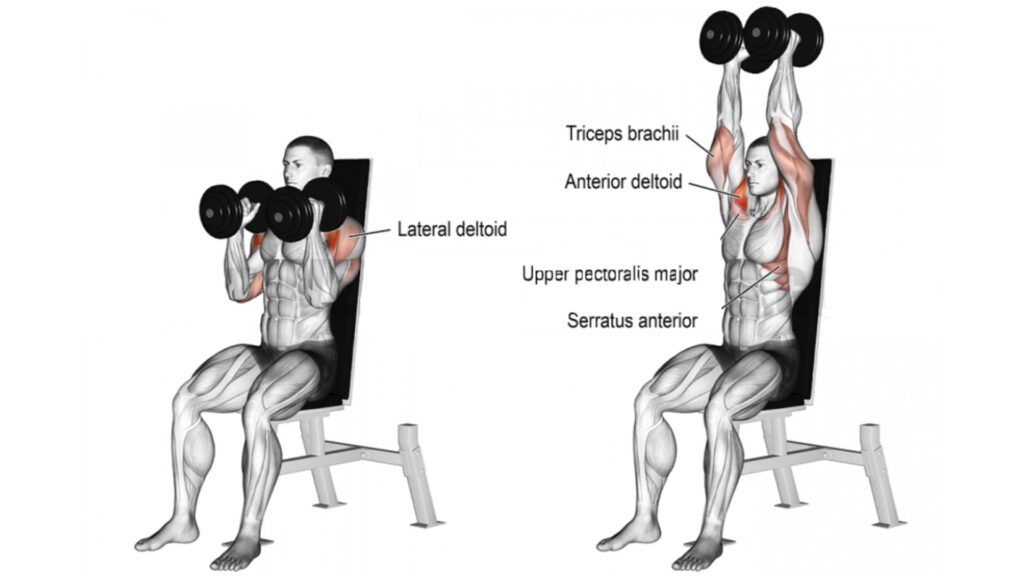
How To Do It
- Sit on a bench with your feet firmly planted on the floor.
- Hold a pair of dumbbells at shoulder height.
- Your palms should be facing each other, and elbows pointed forward.
- Press the dumbbells straight up overhead until your arms are fully extended without locking the elbows.
- Lower the dumbbells back to the starting position in a controlled manner.
- Pause for a second at the top of the movement, then slowly lower the dumbbells back down to the starting position.
- Repeat for 8-12 repetitions, aiming for 3 sets.
Tips
- Keep your back and neck neutral.
- Do not lock out your elbows.
- Keep your elbows tucked in close to your sides. Avoid letting them flare out to the sides.
- Always warm up before training heavily to prevent shoulder discomfort.
9. Dumbbell lateral raise
Dumbbell lateral raise is a simple yet effective exercise that can help you target the shoulders, particularly the lateral or middle deltoid muscles.
Many variations of the dumbbell lateral raise challenge your muscles even more and help build strength and definition.
Some examples of variations include single-arm raises, chest-supported side raises, and dumbbell lateral to-front raises.
I usually do 10-12 reps of single-arm raises on each side to train my lateral delts effectively.

How To Do It
- Stand holding a dumbbell with one hand.
- Feet are shoulder-width apart and knees are slightly bent.
- Now bend your elbow and raise the dumbbell to your side.
- Lift them to a point slightly higher than your shoulder.
- Now lower the dumbbell in a controlled manner back to the starting position.
- Perform all reps on one side and then repeat with the other arm.
Tips
- Pause momentarily at the top before slowly lowering the dumbbell back to the starting position.
- Keep a controlled motion and avoid jerky movements.
- Avoid arching of the lower back.
10. Incline Bench Rear Lateral Raise
The incline bench rear lateral raise is an upper-body exercise that targets the posterior or rear deltoids and the postural muscles of the upper back.
Because it targets such small muscles, this exercise is usually performed with lightweight for high reps, such as 10-15 reps per set or more.
The incline bench removes the potential of using momentum, making the movement more challenging.
It helps to develop bigger, more balanced, and healthier shoulders.
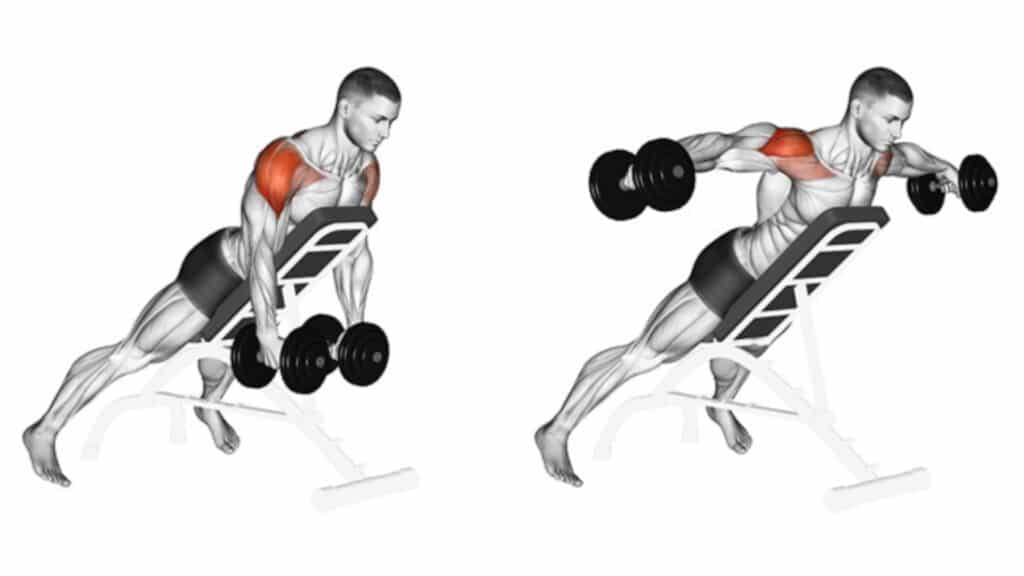
How To Do It
- Sit in the reverse direction on an incline bench ( 45 degrees) while holding dumbbells with neutral grips.
- Hold the dumbbells so that they hang straight down from your shoulders.
- Slowly lift the dumbbells up and out to the sides of your body, pulling through the rear delts and middle traps.
- Pause a moment at the top of the motion before slowly lowering the weights back down to the starting position.
Tips
- Do not lift backward or forward.
- Set a bench at about 30-45 degrees inclined.
- Keep form strict to isolate the rear delts.
11. Side-Lying Rear Fly
You can add single-arm exercises when doing a shoulder workout with a dumbbell at home to correct potential imbalances.
The side-lying rear delt fly is an upper back exercise used to target the rear delts and rhomboids.
It is a great unilateral exercise used to target a smaller and often lagging muscle group.
Instead of lying on the floor, you can lie on a bench.
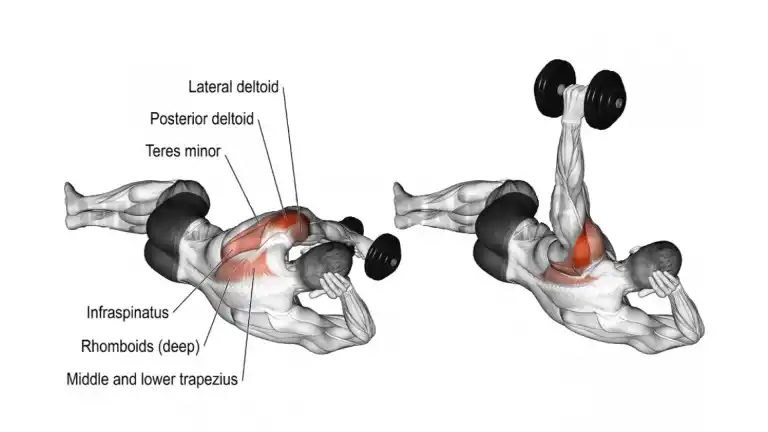
How To Do It
- Lie on the floor on your right side, and grasp the dumbbell with your left hand using a neutral grip.
- Keeping your elbow fixed and your body still, exhale as you raise the dumbbell from the floor until it becomes almost vertical. Hold for a count of two.
- Inhale as you reverse the movement and lower the dumbbell towards the starting position, stopping before the dumbbell touches the floor.
- Repeat for the desired number of repetitions.
- Repeat the exercise on your opposite side with your right arm.
Tips
- Do not allow the dumbbell to touch the floor.
- Keep the abs braced, and don’t arch the back at the top of the movement.
- Allow the arms to move freely, but don’t lock out the elbows.
12. Dumbbell Push Press
The dumbbell push press uses the force of the legs, core, shoulders, and arms to lift two dumbbells to full extension overhead.
It targets various muscle groups simultaneously, including the deltoids, trapezius, glutes, hamstrings, quads, core, and triceps.
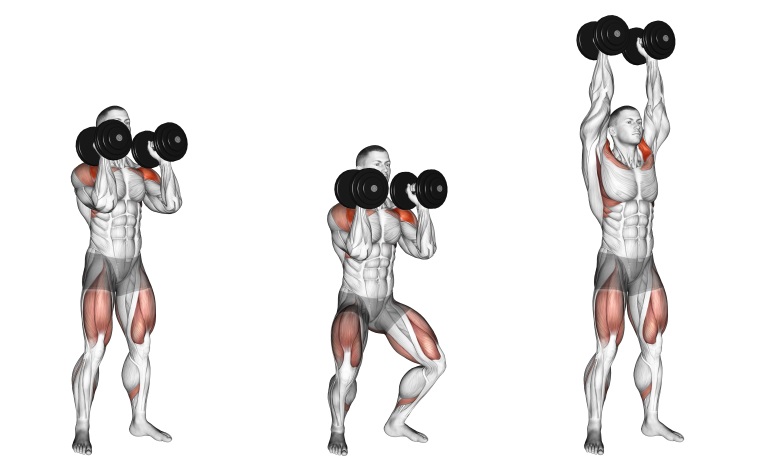
How To Do It
- Stand with feet shoulder-width apart.
- Hold dumbbells at shoulder height, palms facing forward.
- Perform a slight dip with your knees, bending them slightly to generate momentum.
- Explosively drive upwards, extending your legs and hips.
- Use this momentum to push the dumbbells directly overhead.
- Slowly lower the dumbbells back to the starting position.
- Re-establish your starting position and prepare for the next repetition.
Tips
- Master the form with lighter weights before increasing intensity.
- Don’t push the dumbbells forward; focus on pressing directly overhead.
- Don’t dip too deep; a quarter-squat is enough to generate momentum.
Dumbbell Shoulder Workout Technique and Routine Plan
Training the shoulders for strength is a must, and beginners can build up a solid foundation with dumbbells alone at home and in the gym.
However, working in heavy low-rep presses to increase your maximal strength will be important as you become more advanced.
However, we are here to build up some bigger shoulders. So, we will concentrate on moderate to heavy load for reps between 8 and 15. They is a magical rep range for shoulder hypertrophy.
Here are some general recommendations for programming dumbbell shoulder workouts for muscle growth.
Training Plan As Per Your Goal
- For muscle endurance: Aim for 3-4 sets of 12-15 reps, with moderate resistance.
- For muscle strength: Aim for 3-5 sets of 6-10 reps, with more resistance.
- For muscle hypertrophy (increased muscle size): Aim for 3-4 sets of 8-12 reps, with a moderate to heavy amount of resistance.
It is always best to start with fewer reps and sets and then gradually increase as your strength improves.
Furthermore, it is important to allow for adequate rest between sets, typically 60-90 seconds.
Training Volume (Sets and Reps)
Of course, the number of sets and reps will be determined based on your fitness journey, but here is a great starting point:
| Experience Level | Sets Per Week | Reps | Load |
|---|---|---|---|
| Beginners | ~10 sets | 15-20+ reps | Light Load |
| Beginners | ~10 sets | 8-15 reps | Moderate Load |
| Intermediate | ~15 sets | 8-15 reps | Moderate Load |
| Intermediate | ~15 sets | 6-8 reps | Heavy Load |
| Advanced | ~20 sets | 15-20+ reps | Light Load |
| Advanced | ~20 sets | 8-15 reps | Moderate Load |
| Advanced | ~20 sets | 6-8 reps | Heavy Load |
Note: When progress stalls, increase the number of sets to stimulate further development. Ensure the load is challenging enough to bring you to or near failure within the specified rep range.
Dumbbell Shoulder Workout Routine For Beginner
This workout contains multiple exercises that are designed to target all the muscles in your shoulder and increase overall muscle mass.
Here’s a beginner shoulder exercise routine with dumbbells that you can do at home:
| Exercise | Sets | Reps |
|---|---|---|
| Dumbbell Shoulder Press | 3-4 | 8-10 |
| Dumbbell Lateral Raise | 3-4 | 8 |
| Bent Over Raise | 4 | 8-10 |
Workout Routine For Intermediate
Here is an intermediate shoulder dumbbell workout routine that can be done anywhere:
| Exercise | Sets | Reps |
|---|---|---|
| Arnold Shoulder Press | 4 | 8-10 |
| Seated Neutral-Grip DB Press | 3-4 | 10-12 |
| Dumbbell one-arm lateral raise | 4 | 10-12 |
| Dumbbell Upright Row | 3 | 8-10 |
Workout Routine For Advance
Here’s a sample dumbbell-only workout plan for advanced:
| Exercise | Sets | Reps |
|---|---|---|
| Dumbbell Shoulder Press | 4 | 8-12 |
| Dumbbell Front Raise | 3-4 | 10-12 |
| Incline Bench Rear Lateral Raise | 4 | 8-10 |
| Dumbbell Upright Row | 3 | 10-12 |
| Dumbbell Shrug | 3 | 8-10 |
Note:
It’s a good idea to add a variety of exercises to your shoulder workout routine to target the muscle from different angles and provide overall muscle growth.
Be smart: don’t limit yourself to dumbbell shoulder exercises. Get the benefits they offer and use other shoulder exercises to supplement them when needed.
- Barbell Shoulder Exercises To Build Mass And Strength
- Best Cable Shoulder Workout & Exercises For 3D Deltoids
- 21 Bodyweight Shoulder Exercises: No Equipment
A dumbbell workout can be easily added to your shoulder training program.
It can be especially effective when used with a bodyweight barbell, machine, or cable to build the biggest, strongest shoulder possible.
Shoulder Muscles Anatomy
You should know your shoulder muscles to train them effectively With Dumbbells. In fitness, “shoulder exercises” refer to resistance exercises that target the deltoid muscle.
The deltoid is the superficial muscle that forms the rounded contour of your shoulder.
While the deltoid is technically a single muscle, anatomically speaking, it has three distinct sets of muscle fibers and muscle bellies, which are referred to as “heads.
1. Deltoids
The deltoids make up the rounded contour of the shoulders. There are three sections of the deltoids:
- The anterior deltoid (In front): Run along the collarbone and lift the arms forward and upwards.
- Lateral deltoid (at the side): Form the widest part of the shoulders. Lift the arms out to the sides away from the body (abduction).
- Posterior (rear) deltoid: Located on the back of the shoulders. Draw the arms backward.
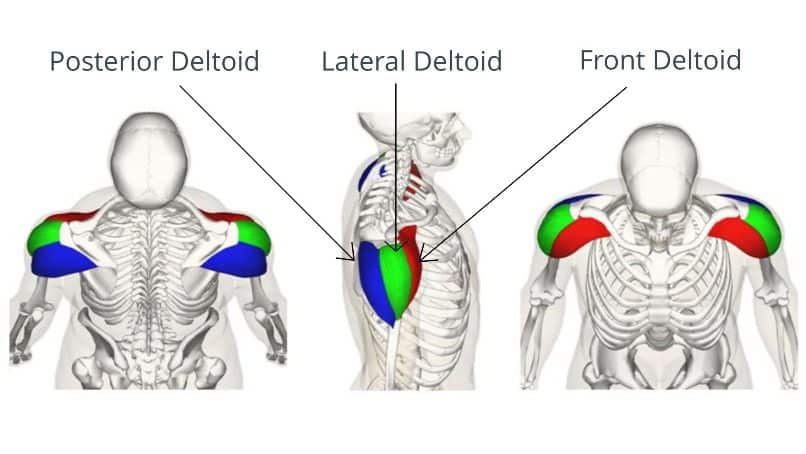
2. Rotator Cuff
The rotator cuff is made up of 4 smaller muscles that stabilize the shoulder joint:
- Supraspinatus: Runs along the upper shoulder blade. Initiates arm abduction.
- Infraspinatus: Covers the rear-outer shoulder blade. Rotates arm outward.
- Teres Minor: Below infraspinatus, the arm is also externally rotated.
- Subscapularis: Front inner portion of the shoulder blade. Internally, it rotates the arm.
3. Trapezius
The trapezius is a large, triangular upper back muscle. It has several roles:
- Middle fibers – Retract shoulder blades together.
- Upper fibers – Elevate shoulder blades.
- Lower fibers – Depress shoulder blades downwards.
The shoulders are shallow ball and socket joints that can move in multiple directions and require many muscles and flexibility to do this. This is why working on the shoulder from all sides is important to strengthen it.
Benefits Of Doing Shoulder Workout With Dumbbell
Multiple reasons motivate you to do shoulder dumbbell exercises; I’ve mentioned seven below.
- A dumbbell shoulder workout requires more balance than barbells or machines, which can lead to greater muscle fiber recruitment.
- It requires more muscular control than barbells, enhancing kinaesthetic awareness.
- When you are doing an upper shoulder workout with dumbbells, it’s impossible to take compensating movement from your strong side. This reduces the risk of muscle imbalance.
- It allows for greater joint safety and stabilization and allows the joints to move naturally within their range of motion.
- It affords a greater variety, preventing physical and mental burnout.
- Dumbbell variations allow for a greater range of movement (ROM), leading to increased muscle fibers recruited.
- It allows unilateral training (training one limb at a time), increases core stability, and improves muscular imbalances.
- Dumbbell workouts are perfect for the at-home exerciser with limited space.
FAQs
How can I work my shoulders with dumbbells at home?
You can work your shoulders with dumbbells at home by doing exercises such as:
- Dumbbell Shoulder Press
- Dumbbell Lateral Raise,
- Dumbbell Front Raise
- Dumbbell Rear Delt Fly
- Dumbbell Upright Row.
- Dumbbell Shrug
Start with lighter weights and gradually increase as you build strength and control.
Are dumbbell shoulder exercises safe?
Dumbbell shoulder exercises can be safe if performed correctly with proper form and technique.
It is important to warm up well before each workout. Start with lighter weights and work up to heavier ones.
Can I do dumbbell shoulder exercises every day?
Doing dumbbell shoulder exercises every day is not recommended.
You should give your shoulders at least 24–48 hours of rest between workouts to allow for adequate recovery and prevent injury.
How many shoulder exercises per workout
Per workout session, it is recommended to perform 3-4 different shoulder exercises.
When performing a dumbbell shoulder workout, it’s important to target all three heads of the deltoid muscle: The anterior head, medial head, and posterior head.
The best way to do that is by doing exercises such as overhead presses, lateral raises, bent laterals, and reverse flies.
Performing 3-4 sets of 8-12 reps of each exercise is recommended for most workouts.
How do you target the three parts of the shoulder?
No single exercise can effectively target all three heads of the shoulder (anterior, medial, and posterior) in isolation.
However, incorporating various exercises into your routine can effectively target all three heads of the shoulder and provide a well-rounded shoulder workout.
Some of the best exercises for hitting all three heads of the shoulder include:
- Dumbbell Overhead Press—Mainly targets the anterior, lateral head of the shoulder
- Dumbbell Lateral Raise—Mainly targets the medial head of the shoulder
- Dumbbell Front Raise—Mainly targets the anterior head of the shoulder
- Dumbbell Rear Delt Fly—Mainly targets the posterior head of the shoulder
- Dumbbell Upright Row—targets all three heads of the shoulder to a lesser extent
Conclusion
These dumbbell shoulder exercises are highly recommended for anyone interested in building a wider shoulder and who wants to gain strength.
It allows for targeted muscle development and provides an overall 3D look to the shoulder. It is easy to do and requires no more scientific details and fancy equipment.
Dumbbells can be used to perform compound and isolation exercises, and, best of all, they’re ideal for home and gym workouts.
The results will speak for themselves if you consistently do these dumbbell shoulder workouts.
References
- 1Xiaofeng Jia Jong-Hun Ji, Steve A Petersen, Jennifer Keefer, Edward G McFarland: Clinical Evaluation of the Shoulder Shrug Sign Strength and Conditioning Journal: Clinical Orthopaedics and Related Research: November 2008 – Volume 466 – Issue 11 – p 2813-2819
- Ronai, Peter MS, CSCS, RCEP: Exercise Modifications and Strategies to Enhance Shoulder Function. Strength and Conditioning Journal: August 2005 – Volume 27 – Issue 4 – p 36-45
- McAllister M, Schilling B, Hammond K, Weiss L, Farney T. Effect of grip width on electromyographic activity during the upright row. J Strength Cond PMID: 22362088 DOI: 10.1519/JSC.0b013e31824f23ad

Manish brings over 10 years of hands-on experience in weight lifting and fat loss to fitness coaching. He specializes in gym-based training and has a lot of knowledge about exercise, lifting technique, biomechanics, and more.
Through “Fit Life Regime,” he generously shares the insights he’s gained over a decade in the field. His goal is to equip others with the knowledge to start their own fitness journey.
